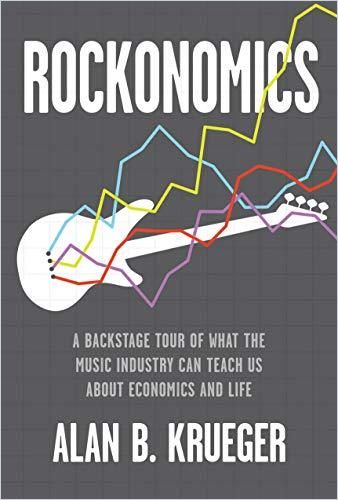Is America’s music scene the perfect metaphor for the US economy? Economist Alan Krueger thinks so. For every platinum-selling artist, he says, there are millions of musicians who never earn a living wage. Krueger offers noteworthy insights and information for executives, music lovers and executives who happen to be music lovers.

The Underbelly of Rock and Roll
No less an authority than legendary producer Quincy Jones regards the late Princeton professor and economist Alan Krueger as an exemplar in engaging the right and left aspects of the brain. Jacob Slichter, drummer in the band Semisonic – of the hit “Closing Time” – and author of the above-average rock memoir So You Wanna Be a Rock and Roll Star, finds that Krueger demonstrates a rare understanding of the deliberately complex finances of the rock world.
Those outside the music industry also offer high praise – writer Andrew Tobias, author Harlan Coben and economics Nobel Prize-winner Richard Thaler, among others. Their delight with Krueger’s insights demonstrates that few people write well about the financial underbelly of rock and that everybody – from drummer to egghead – likes to read about it.
A Unique Lens
Krueger’s thesis is that the industry that produces rock, pop, rap and other musical genres offers a unique lens through which to examine US economic forces. He makes plain how rock and roll illuminates inequities in the US economy.
Krueger notes that the top 1% of all US earners captured 22% of GDP in 2017, compared to 10% in 1979. Within the music industry, the top 1% of today’s artists command 60% of music revenues, compared to 26% in 1982. Thus, Krueger convincingly argues, the music industry reflects core economic principles, including supply-and-demand dynamics, price segmentation, cost controls and incentives.
The time we spend listening to music is up, while spending on music is down by 80% in real terms since 1999.Alan Krueger
You may be surprised to read that the US music industry generated only $18.3 billion in 2017 – 0.1% of US GDP. Yet 80% of Americans, Krueger reveals, listen to music daily at an average cost of only $0.10.
Streaming
Krueger explains that streaming platforms such as Spotify, Apple and YouTube added $2 billion in revenue to the music business in 2015. Users streamed, he reveals with awe, one trillion songs in 2017. Music “rented” via streaming accounts for roughly 66% of recorded music income. Platforms pay out between 65% and 70% of their revenue in royalties. Streaming’s global growth will encompass one billion users by the mid-2030s.
The advent of paid streaming – the latest in a long line of disruptive technologies – is beginning to cause artists’ revenue from recorded music to rebound.Alan Krueger
Krueger offers this as a perfect example of how new delivery systems can revive entire industries. He returns to his theme of the nondemocratic distribution of wealth: Some 50% of recorded and streaming music sales, he explains, flow to the upper 0.1% of musicians.
But It’s Not That Much
Krueger lays out some depressing numbers: As of 2016, more than 213,000 people in the United States claimed music as their profession. They represent 0.13% of the overall labor force – a figure unchanged since 1970. The typical artist, Krueger reports, earned roughly $20,000 in 2016.
The US job market had become a superstar, winner-take-all affair, much like the music industry, where a small number of top performers did fabulously well, while almost everyone else struggled to make ends meet.Alan Krueger
Krueger takes you back to the merciless basics: Supply and demand drive those low earnings. The high supply of performers pushes incomes lower for all musical artists – except the elite.
The Top 10%
Krueger’s explication of the economic divide in the US economy may shock you: Since 1980, 100% of income gains have flowed to the top 10% of earners, leaving the bottom 90% behind.
The “superstar market” drives income and wealth disparity, Krueger discloses, in the music industry and in the US economy. Each star must stand apart from the crowd. If all musicians – or executives – possessed the same talent, Krueger posits, then a select group could not command premium wages.
Cash Money
Krueger underscores that making records doesn’t make money. The upper echelon of performers earns more from performing live than the bottom 99% earn in total. Krueger doesn’t make clear how he feels about this statistic, but he divulges that, since the early 1980s, the group U2 has generated more live performance revenue than any other musical band.
The late David Bowie once remarked, ‘Music itself is going to become like running water or electricity….You’d better be prepared for doing a lot of touring because that’s really the only unique situation that’s going to be left’.Alan Krueger
Once again, Krueger relates how those at the top run the market: As of 2017, the four biggest promotion companies controlled two-thirds of US live performance revenue. And he breaks down the mind-blowing, disheartening statistics: Between 1996 and 2018, the average cost of a live performance ticket rose 190%. Compare that to overall price levels, which increased just 59% during the same period.
Business Is Business
Krueger spells out the hard road: Musicians suffer contract pitfalls, expense overruns, accounting irregularities, unreported revenue and outright fraud by promoters, managers and record labels. Musicians get to keep between 13% and 20% of their recorded music sales income.
There is a fundamental disconnect at the heart of the music business today: The way artists earn most of their money differs dramatically from the way most fans enjoy the music artists create.Alan Krueger
Krueger offers the enduring truth that no more than two of every 10 albums earn back their expenses. Many bands, like the Beatles, dissolve over money differences. Krueger, with all the good will in the world, suggests that performers hire worthy managers, save more than they spend and control their expenses. But how many do that?
Copyrights
Krueger ventures gamely into the swamp of copyrights. He states simply that copyright protection means command over content. Who owns and who owes, Krueger makes clear, motivates every artist, producer and label.
The music industry can help to explain how the economy works and how economic forces are changing our lives. And economists can learn new insights about the economy and human behavior from studying the music industry.Alan Krueger
Music and content exemplify intellectual property. Stakeholders must sort out copyright enforcement for usage, time duration and user payments to rights holders. While US copyright extends 70 years past the life of the creator, Krueger explains that copyright regulation is unclear in regard to royalty payments, which lack uniformity across radio and streaming. Here, Krueger highlights yet another arena in which artists don’t get their due.
Big Spenders
Krueger cites Americans as the biggest spenders on music, followed by the Japanese and British. Approximately one billion Chinese now listen to music weekly. The country will soon dominate music buying, but China, Krueger insists, must make progress in dealing with royalties, censorship and copyrighting.
Harsh Truth
Krueger is a brilliant, engaging writer – for an economist, anyway – with a startling, irreverent sense of humor. His subject requires wit, because Krueger’s main point is unrelentingly serious – neither the rock world nor the US economy offer hope for those on the bottom. Krueger understands that the fantasy of rock stardom and of making a fortune remains seductive, while the truth continues to be harsh.








